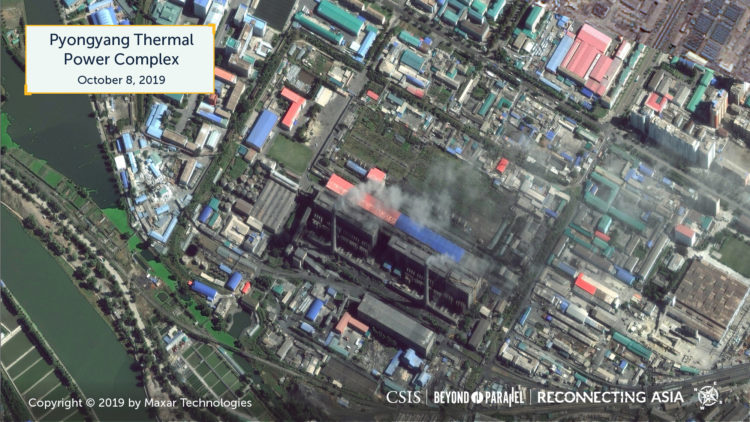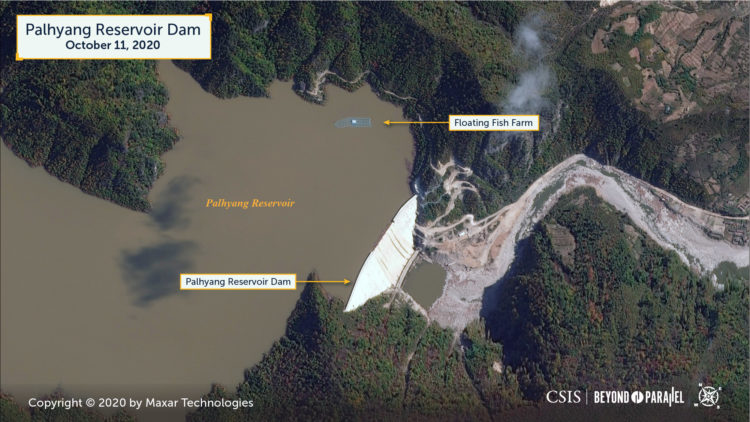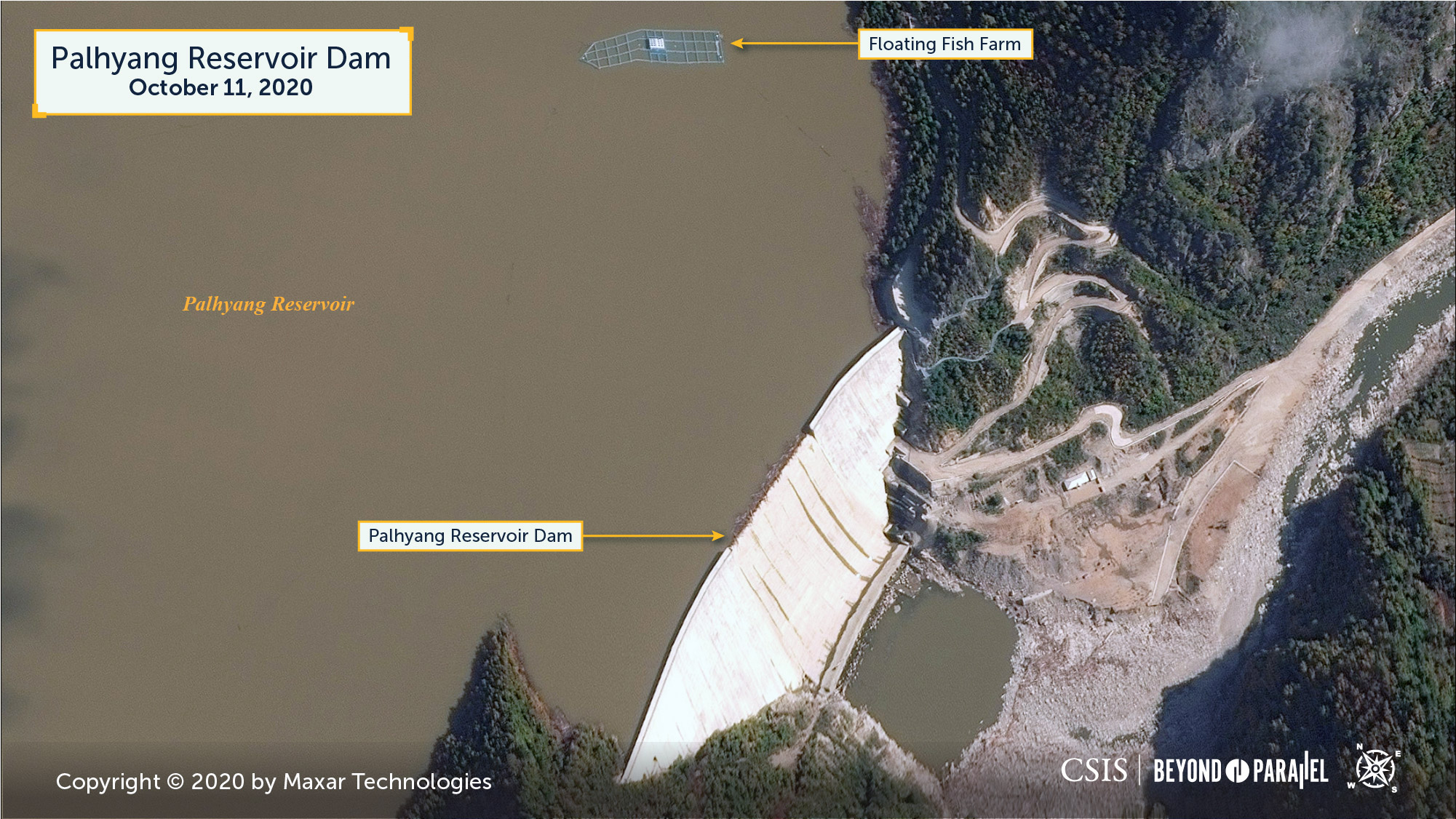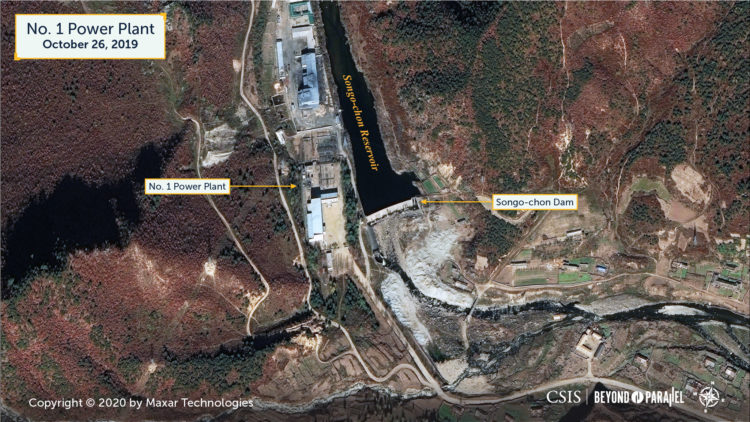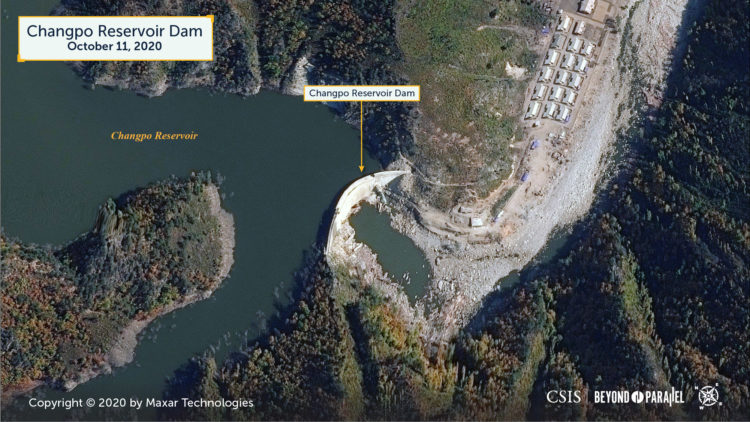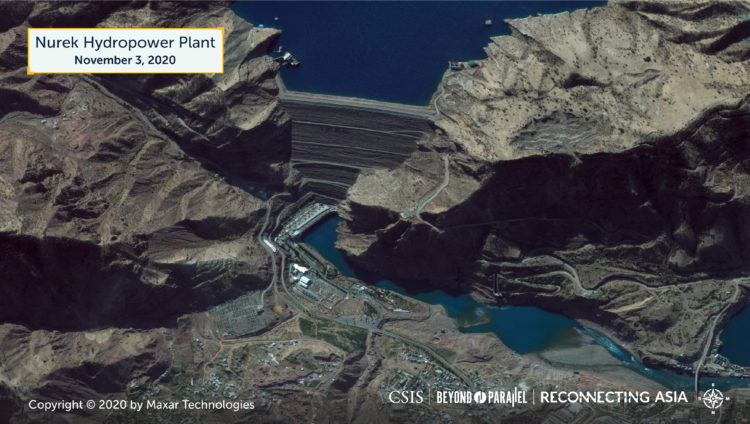
Powering the Korean Peninsula: Economic and Strategic Considerations
Executive Summary
Negotiations between North and South Korea have revived prospects for reconnecting the Korean peninsula. South Korean president Moon Jae-in and North Korean leader Kim Jong-un came to an agreement in 2018 to advance broader inter-Korean relations. A critical aspect of connectivity is energy infrastructure, which will require analysis and technical planning to make the most of any future political openings. Satellite photos of the Korean peninsula at night illustrate the vast gap in current energy capabilities between a vibrant South and a dark North.
This report makes several contributions. First, it uses satellite imagery to evaluate two key projects in North Korea against global standards. It confirms that the Pyongyang Thermal Power Complex, one of North Korea’s two largest thermal electricity producers, is in a state of dire disrepair. The Orangchon Power Station Project, though under construction for over three decades, remains incomplete. Both projects fail to meet the Group of Twenty (G20) Principles for Quality Infrastructure Investment announced in June 2019. These initial evaluations underscore the poor state of North Korea’s existing energy infrastructure and its significant need for quality investment.
Second, this report illustrates different models for delivering energy projects. It uses the G20 quality infrastructure principles to evaluate three power projects in Asia. These projects were selected to represent a spectrum of quality infrastructure practices in developing economies that have limited connectivity and few resources. Nurek Hydropower Plant in Tajikistan meets most quality infrastructure principles. Payra Coal-Fired Power Plant in Bangladesh highlights the risks posed by poor transparency and weak environmental and social safeguards. Angren Thermal Power Plant in Uzbekistan shows how corruption harms the environment, hinders the project’s operations, and prevents growth. Collectively, these cases illustrate which practices the Korean peninsula should either emulate or avoid.
Finally, this report considers the strategic implications of reconnecting the Korean peninsula through energy infrastructure. Examples like the European Coal and Steel Community show how forging economic connections can help build the foundation for a lasting peace. But interdependence can also be weaponized, as Russia’s and China’s histories of using energy infrastructure as tools of coercion show. The United States should be mindful of these considerations as it works in coordination with its ally South Korea to ensure that a reconnected Korean peninsula develops in a manner that is sustainable, open, and resilient.
G20 Quality Infrastructure Investment Principles
At the annual G20 Summit in June 2019, leaders from the world’s wealthiest economies adopted the G20 Principles for Quality Infrastructure Investment. The document presents a framework of voluntary, non-binding principles to make such investments more sustainable and transparent in the future.
Principle 1: Maximizing the Positive Impact of Infrastructure to Achieve Sustainable Growth and Development. Quality infrastructure investment should ensure sound public finances while also maximizing the positive economic,environmental, social, and developmental impacts of infrastructure to stimulate “a virtuous circle of economic activities.”
Principle 2: Raising Economic Efficiency in View of Life-Cycle Costs. Quality infrastructure investment should be affordable and attain economic, social, and environmental value relative to a project’s life-cycle costs during all stages of the project, including “planning, design, finance, construction, operation and maintenance (O&M), and possible disposal.”
Principle 3: Integrating Environmental Considerations in Infrastructure Investments. Quality infrastructure investment should account for the positive and negative impacts of projects on ecosystems, biodiversity, climate, weather, and resource use throughout the infrastructure investment process.
Principle 4: Building Resilience against Natural Disasters and Other Risks. Quality infrastructure investment should ensure the long-term adaptability of infrastructure and build resilience against the onset of environmental changes, and the growing number and magnitude of natural disasters and man-made risks.
Principle 5: Integrating Social Considerations in Infrastructure Investment. Quality infrastructure investment should enable the economic participation and inclusion of all and should consider and manage economic and social impacts throughout the life cycle of a project.
Principle 6: Strengthening Infrastructure Governance. Quality infrastructure investment should be governed soundly through the development of clear rules, robust institutions, and good governance to ensure cost-effectiveness, accountability, transparency, and integrity throughout the project life cycle.
Case Study 1: Pyongyang Thermal Power Complex
Pyongyang Thermal Power Complex, also referred to as Pyongyang Combined Heat and Power (CHP) Plant, is located in the Pyongchon District of Pyongyang. The complex has a design capacity of 0.7 gigawatts (GW) and an estimated capacity of 0.5 GW. Initially constructed in the 1960s with support from the Soviet Union, over the intervening decades it has received modernization and maintenance investment and aid from the United Nations Development Program (UNDP), Russia, and China. Originally designed to supply electricity only to the Pyongyang Industrial District, the complex has supplied much of the capital city’s electricity. While reportedly in a state of dire disrepair by global standards, the complex is regarded as one of the two largest electricity producers among North Korea’s thermal power plants.
Quality Evaluation
Principle 1: Sustainable Growth and Development
The Pyongyang Thermal Power Station is one of the largest thermal power plants in the country and supplies electricity to both the industrial district and residences in the capital city. However, reports over several decades indicate that major equipment at the complex has deteriorated, and it lacks a comprehensive maintenance program. As early as 1993, Nautilus Pacific Research found a shortage of skilled staff able to operate the limited equipment available. In such a state of disrepair and with limited investment in the facility’s maintenance, positive spillover effects for sustainable economic growth are severely limited. Media reports attributing pollution and environmental damage to the complex indicate environmental and social considerations for sustainable development have not been effectively implemented as a part of any of the life-cycle or modernization investment plans for the complex.
Principle 2: Economic Efficiency and Life-Cycle Costs
Financing for the initial construction of the Pyongyang Thermal Power Complex was provided pursuant to the December 24, 1960 assistance agreement between North Korea and the Soviet Union. While details about the complex’s financing and O&M are sparse, in 1998 the UNDP provided funding to install administration and operation computer technology and to modernize the generation facilities. In 2002, Russia signed an agreement to assist with additional modernization, although this may have resulted merely in a visit to the complex by a Russian technical delegation. 1 Following a series of North Korea–China summits in 2018, there has been a reported increase in Chinese investment and aid, most notably the delivery and installation of two power generators in July 2018 (potentially in violation of international sanctions).
Even with foreign aid and investment, the complex evidently lacks sufficient financing and plans for its operation and maintenance. News reports indicate the complex undergoes repair and maintenance procedures for turbines, generators, and boilers on a near-monthly basis. 2 Some South Korean news reports have also indicated that the government has considered closing the complex altogether, deeming it highly inefficient. However, at present, there are not sufficient alternative sources of power generation for the area the complex serves.Amid restrictions imposed by international sanctions, it is doubtful that the most current and innovative technologies will be leveraged toward economic efficiency in the complex’s life-cycle costs in the foreseeable future.
Principle 3: Environmental Considerations
If environmental impact assessments (EIAs) were conducted for either the 2002 modernization project with Russia or the 2018 generator upgrade project with China, they are not currently available to the public. There is no open-source information to indicate that EIAs were shared with stakeholders or that ecosystem-based adaptations have been explored. However, given local and South Korean media reports attributing excessive amounts of air and water pollution to this plant, it appears unlikely that any such adaptions have been considered or implemented to any meaningful degree.
UNDP resources and programs in the 1990s did seek to reduce environmental damage caused by North Korea’s older power plants, including the Pyongyang Thermal Power Station, by providing improved power generation designs, modern computerized systems, and better training for professional staff. However, according to the 2012 “Democratic People’s Republic of Korea Environment and Climate Change Outlook,” published by the UNDP and North Korea’s Ministry of Land and Environmental Protection, air quality in parts of Pyongyang has continued to exceed acceptable levels.
A 2003 report by the UNDP and North Korea’s National Coordinating Committee for the Environment did outline and assess country-wide environmental concerns. Although the assessment was not specific to the Pyongyang Thermal Power Complex, it did propose a joint project to introduce dust collection at the plant. Including the report’s considerations in the complex’s ongoing and future investment plans could greatly mitigate its environmental impact.
Principle 4: Disaster Risk Management
A comprehensive disaster risk management plan is not currently publicly available, so it cannot be verified whether such plans have been used in the plant’s design, modernization, or maintenance or taken into consideration when drafting protocols to re-establish essential services in case of an emergency. Project financing terms and agreements are also not publicly available, so financing for preventive measures, disaster risk mitigation, and insurance cannot be verified.
Principle 5: Social Considerations
It cannot be verified whether social impacts have been considered as an important component in either the maintenance and operation of the complex or its most recent modernization projects.
Details on the complex’s occupational safety and health policies are not readily available.
However, news reports suggest medical teams visit the complex to offer services and treatment to employees. North Korean state media indicates university student delegations visit the complex as part of collaborative efforts to improve internal infrastructure. Visiting technical teams from Russia and China—and past projects with the UNDP—have also made isolated efforts to develop workforce skills through the projects they sponsor.
Principle 6: Governance
The Pyongyang Thermal Power Complex is overseen by the Pyongyang City Bureau of the Ministry of Electric Power Industry. This institution is presumably responsible for undertaking the cost-benefit analysis of the complex, assessing its financial sustainability, and prioritizing potential projects.
There is no evidence that the decisionmaking, bidding, and execution processes for any of the modernization or O&M projects at the Pyongyang Thermal Power Complex have been transparent, fair, informed, or inclusive.
Imagery Analysis of Current Status
The complex encompasses approximately 38.8 hectares (95.9 acres) and is served by both rail and road. Coal is regularly supplied via a railyard immediately south of the complex. Water for cooling and other purposes is supplied from a canal feed by the Potonggang (“Potong River”), which runs along the west side of the complex. High voltage power lines, originating in the switch (transformer) yard, exit the complex to the north, south, and east. There are undoubtedly underground power lines exiting the complex as well. What appear to be pipelines for steam exit the complex to the north.
The complex has been operational since the mid-1960s and continues to be operational today, as determined by the emanation of smoke from one or both of the two stacks in all 57 satellite images reviewed for this report from August 1965 to November 2020. Additionally, smaller plumes are frequently visible emanating from roof vents of the generator hall in most satellite images. Numerous rail cars are observed in the rail yard servicing the facility in these same satellite images. 3 Although the majority of these rail cars are ore (coal) cars or gondolas, locomotives of various sizes, box cars, tank cars, flat cars, and even the occasional passenger car are also observed in the rail yard.
While observable changes have taken place since the early 2000s, available satellite imagery suggests that these have not been transformational and that significant investment would likely be required to replace old and inefficient power generation and distribution equipment, modernize operations to make them economically viable by foreign standards, bring the plant up to internationally accepted operating and safety standards, and address what may be significant environmental issues.
Satellite imagery from June 2000 shows that, although the main power generation and delivery components of the Pyongyang Thermal Power Complex remained largely the same, numerous changes had been made to the facility’s original support infrastructure. Among the more notable changes were developments in the switch yard, construction of headquarters and administration facilities, expansion of both the water treatment facility and standby fuel storage area, addition of settling ponds, and expansion of the rail lines and yard servicing the complex, and the bus terminal adjacent to the complex. Additionally, the industrial infrastructure immediately adjacent to the complex, which most likely either serves a critical support role or is heavily dependent upon the complex, continued to develop.
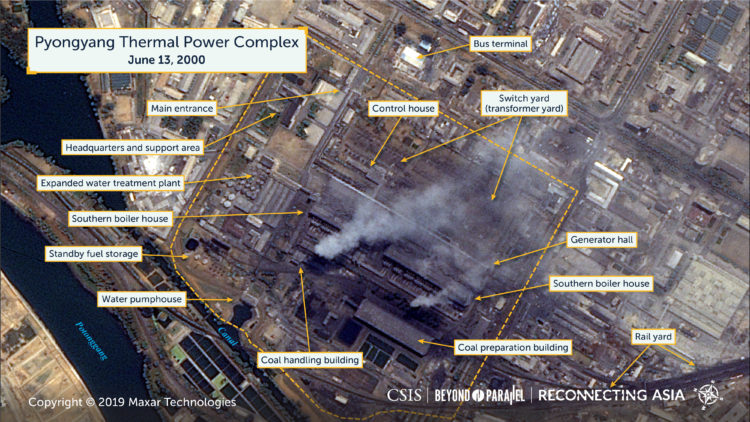
Low-level maintenance activities and minor infrastructure changes within support areas of the complex are visible in satellite imagery from the early 2000s. These activities continued between 2010 and 2018. From 2014 to 2015, roofs were replaced on several small support structures, several settling ponds were filled in, and a small motor vehicle maintenance and storage facility was added. During the winter of 2016, between October 2016 and March 2017, the roof of the generator hall was replaced.
Almost all imagery from January–November 2020 shows smoke issuing from both of the complex’s stacks and regular rail activity delivering coal. This same imagery indicates that low-level maintenance and minor infrastructure changes at the complex have continued, including upgrades to the headquarters and administration facilities, the construction of several small buildings, the installation of new roofs on small support buildings, changes in the switch yard (transformer yard), and additional changes to the industrial infrastructure immediately adjacent to the complex.
Korean Case Study 2: Orangchon Power Station Project
As of December 2020, 33 years since the project began, satellite imagery indicates that the Orangchon Power Station project remains unfinished at approximately 85–90 percent complete. The station sits in the central industrial area for the region where energy demand is high but production has been low or intermittent for more than 25 years. When completed, and if operating at full capacity, the entire Orangchon Power Station Project has a projected generation capacity of 134,500 kilowatts (kW). However, historically endemic problems with quality control, maintenance, the availability of construction supplies, access to spare parts, and other issues raise questions as to whether the project will be able to operate at full capacity.
Quality Evaluation
Principle 1: Sustainable Growth and Development
Although the Orangchon project was initiated as a part of the North Korean government’s Third Seven-Year Economic and Social Development Plan (1987–93), there is no indication that efforts were made at the time to widen the investor base, crowd in private investment, or mobilize financing from other sources. While construction officially commenced on June 5, 1988, progress came to a halt shortly afterward. Many sources cite financial constraints as the cause for this lack of headway.
There is significant potential for positive spillover effects to the local and regional economy, as the station sits in the region’s central industrial area, where energy demand is high but production has been low or intermittent for more than 25 years. When completed and if operating at full capacity, the station could stimulate the economy and create a virtuous circle of economic activity in the region. However, questions remain as to whether the project will ever attain full generating capacity due to historically endemic problems with quality control, maintenance, availability of construction supplies, and access to spare parts, among other issues. Consequently, sustainable growth and development will hinge on whether the project can be successfully completed and efficiently maintained.
Principle 2: Economic Efficiency and Life-Cycle Costs
The North Korean regime is investing a relatively significant amount of resources in the project despite facing tightening economic restrictions as a result of international sanctions. This has been especially true since Kim Jong-un assumed power in 2011. He personally visited the plant on July 17, 2018 to understand why the project was only 70 percent complete despite having started construction more than 30 years ago. His criticism and call for the project’s full completion by October 10, 2019—an unachievable goal—clearly resulted in rapid progress on Orangchon, as seen by the completion of its No. 5 Power Plant less than 10 days later, on July 26, 2018. Since then, there has been a steady stream of North Korean media reports recounting the project’s continued progress.
Given the 33-year history of inefficiencies in the construction phase of this project, it is uncertain that a cost-benefit analysis has been employed for the station’s O&M phase. There is no publicly available evidence that mechanisms have been identified to address cost overruns, cover any ongoing O&M costs, or mitigate the risks of delays.
As with the Pyongyang Thermal Power Complex, the restrictions imposed by international sanctions make it unlikely that the most current and innovative technologies can be leveraged to improve the project’s economic efficiency or life-cycle costs in the foreseeable future.
Principle 3: Environmental Considerations
If any EIA was conducted, it is not currently available to the public. There is no open-source evidence available to suggest that an EIA was shared with stakeholders either at the initial launch of the project 33 years ago or following the renewed construction efforts in 2018. It cannot be verified whether any ecosystem-based adaptations have been considered at any point to date in the lifecycle of this project.
As a major hydropower project, the Orangchon Power Station does offer significant potential contributions for long-term, low-emission energy production.
Principle 4: Disaster Risk Management
The region’s droughts and floods over the past 30 years pose critical challenges to the Orangchon Power Station’s infrastructure. Project financing terms and agreements are not publicly available, so the existence of financing for disaster risk mitigation and insurance cannot be verified.
Principle 5: Social Considerations
Labor conditions at the Orangchon Power Station construction site raise significant occupational health and safety concerns, some of which may constitute human rights violations. A 2015 report by South Korean daily Chosun Ilbo claimed that, due to labor shortages, individuals (especially from younger generations) were forcibly dispatched to project construction sites “for seven days and punished with unpaid forced labor.” Likewise, unemployed individuals were also being dispatched to “the most difficult construction sites by receiving ‘labor training camp’ sentences that can last up to six months.” It should also be taken into consideration that approximately 50 percent of the length of the project runs along the northern and eastern borders of North Korea’s No. 16 (Hwasong) political prison camp and that it has often forced political detainees to undertake labor-intensive and dangerous construction projects with little regard for health, safety, or human rights conditions.
Principle 6: Governance
There is no evidence that the decision-making, bidding, and execution processes for the Orangchon Power Station have been transparent, fair, informed, or inclusive.
Since the central government initiated the project, the cabinet has reportedly left oversight and management to province-level officials. Following Kim Jong-un’s inspection and direct involvement in 2018, responsibility for the project was transferred to the Central Committee of the Workers’ Party of Korea. 4 Inspections by other high-ranking officials over the past several years have also served as oversight and monitoring of the construction progress. 5
Political speeches and propaganda such as documentaries, government news outlets, and political essays devoted to illustrating the “glory” of Orangchon Power Station appear to have served as the primary means of informing the public about project developments.
Imagery Analysis of Current Status
The Orangchon Power Station Project is a network of dams, reservoirs, water tunnels, and power plants that generally follow or parallel the watercourse of the Orangchon (“Orang Stream”). The river originates among the Hamgyong Mountains and then drops steeply, providing both sufficient volume and velocity to be converted into electricity. When completed, the Orangchon project will consist of five power plants (Nos. 1–5); four reservoir dams (Changpo, Kwangduk, Palhyang, and Songochon); and at least eight water tunnels. Available North Korean data does not provide precise locations for the Kwangduk Reservoir Dam and No. 3 Power Plant—all northwest of the Palhyang Dam—but satellite imagery identifies several small construction sites upstream along the Orangchon that are undoubtedly these facilities’ locations. As of December 2020, satellite imagery indicates that, as a whole, the Orangchon Power Station Project remains unfinished at approximately 85–95 percent complete.
Palhyang Dam
The Palhyang Reservoir Dam is located at 41.348987, 129.389966. Construction was reportedly scheduled to commence in the late 1980s or early 1990s; however, satellite imagery from May 27, 2003, shows that, while a construction camp had been established and some basic grading was underway, not even the foundations of the dam had been poured. By June 12, 2004, satellite imagery shows considerable progress, with a water channel excavated, the dam foundation partially poured, and a work camp (e.g., batch plant, engineering offices, etc.) established. By June 10, 2008, three large cranes were present, the upper sections of the dam were under construction, and work on the generator halls had begun. Kim Jong-il visited the dam site several times, which kept construction moving, albeit at a slow pace. After Kim Jong-un assumed power in 2011, he increased visits to observe the dam construction activity. During July 2018, Kim made a thorough on-site inspection of the Palhyang dam and called for full project completion by October 10, 2019. Work progressed steadily throughout the year, and on December 15, 2019, North Korean media covered Kim Jong-un officially dedicating the completion of the dam. The dam is the largest structure within the Orangchon Power Station project and serves as its centerpiece.
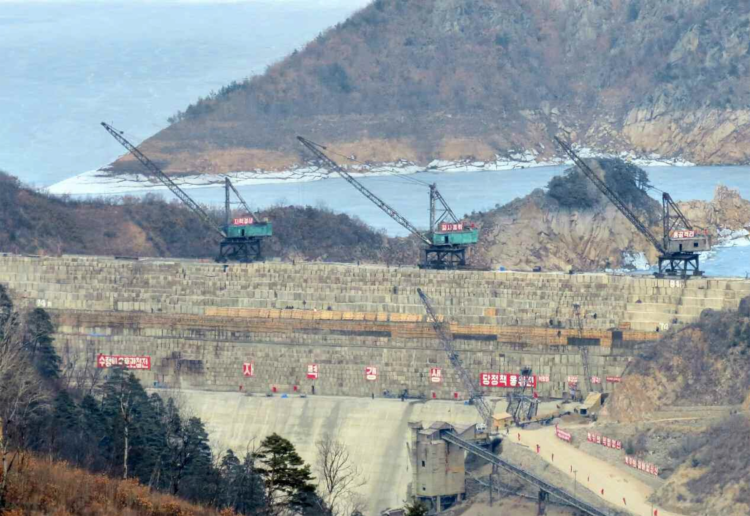

By September 1, 2019, satellite imagery showed that the dam spanned approximately 360 meters (1,180 feet) and that only a small portion of the uppermost sections remained to be poured. While construction continued at a high rate, it could not meet the October 10, 2019 completion date set by Kim Jong-un. While the overall Orangchon complex remains unfinished, the Palhyang Reservoir Dam was completed and dedicated by Kim Jong-un two months later, on December 5, 2019.
North Korean media sources state that the finished height of the dam is 109.5 meters (359.3 feet), and the associated No. 1 Power Plant has a designed generating capacity of 60,000 kW. (A 2019 North Korean report appears to identify the Palhyang Reservoir Dam as the “No. 6 Dam.”)
As of December 3, 2020, the impounded Palhyang Reservoir extends approximately 7.5 kilometers (4.7 miles) upstream and appears close to being full. It also supports what appears to be the beginnings of what could be significant aquaculture activity, with a floating fish farm located near the dam.


Kim Jong-un dedicating the complete Palhyang Reservoir Dam on December 5, 2019. Image credits: RodongSinmun, December 5, 2019.
No. 1 Power Plant
The No. 1 Power Plant is located at 41.402306, 129.510274, adjacent to the village of Songo-gol. Although construction of the No. 1 Power Plant reportedly began at the same time as that of the Palhyang Dam (and was reportedly in “full swing” in 2003), satellite imagery from May 27, 2003, shows that only one construction camp had been established and that some basic grading was underway. Neither the foundations of the power plant nor the Songochon Reservoir Dam had been poured. By June 12, 2004, the power plant’s foundations had been poured and construction was ongoing. Imagery from December 29, 2006, shows that the external structures of the power plant and its two transformer yards were complete and excavation for the future dam had recently begun. On January 27, 2007, North Korean media reports suggested that the No. 1 Power Plant was at least partially operational, claiming, “This year, we must be able to operate the Orangchon Power Plant No. 1 normally to spur power generation.” The No. 1 Power Plant was officially completed on September 12, 2013. During 2014, several buildings were raised, and construction of what appeared to be a small industrial building or coal-fired power plant was in its early stages approximately 70 meters (239 feet) north of the transformer yards. This facility was gradually expanded up until June 22, 2019. The latest available satellite image, from October 26, 2019, shows that the power plant is operational, the approximately 140-meter (460-foot) Songochon Reservoir Dam impounds a small reservoir, and a small stream of water flows into the Chunamchon (“Chunam Stream”). North Korean media reported on September 12, 2019, that both No. 1 and No. 2 Power Plants were “carrying out electricity production plans much more abundantly every day due to the unrelenting spirit of struggle.”
Although there were no significant changes to the No. 1 Power Plant between June 22 and October 26, 2019, there have been some minor expansions around the small industrial building/thermal power plant, including several coal storage bunkers, an addition, and the construction of a small building further to the north.
While the power plant is fed by the small Songochon (“Songo Stream”), North Korean sources indicate that it is also fed directly from the Palhyang Dam via an 11.97-kilometer (7.44-mile) water tunnel that has an elevation drop of 241 meters (791 feet) and a designed generating capacity of 60,000 kW. A small amount of water from the Songochon Dam is released into the Chunamchon, but most is reportedly sent to the No. 2 Power Plant via a 9.86-kilometer (6.13-mile) water tunnel. Unsurprisingly, there are no readily available indications of either water tunnel visible on satellite imagery.
No. 2 Power Plant
The No. 2 Power Plant is located just east of the village of Ussoyo at 41.389140, 129.601752. Construction of the power plant, the water tunnel from the Songochon Reservoir Dam, and the water canal to the Orangchon River began in 2008 or 2009. Satellite imagery from December 9, 2010, shows that the construction of the power plant and attached transformer yards were largely externally complete. North Korean media reported the No. 2 Power Plant was officially completed on September 12, 2013. With the exception of several minor modifications, the facility has changed little since that time. On September 12, 2019 North Korean media reported that the No. 2 Power Plant, along with the No. 1 Power Plant were “carrying out electricity production plans much more abundantly every day due to the unrelenting spirit of struggle.” The latest available satellite image, from October 26, 2019, shows that the power plant is operational, and water is visible in the associated canal.
North Korean sources indicate that the power plant is fed directly from the Songochon Dam via an 9.86-kilometer (6.13-mile) water tunnel that has an elevation drop of 141.4 meters (463.9 feet) and a designed generating capacity of 24,000 kW. Water exits the power plant into an approximately 1.6-kilometer (1-mile) canal that feeds into the Chunamchon immediately north of the entrance to the water tunnel that feeds the No. 5 Power Plant.
No. 5 Power Plant
The No. 5 Power Plant is located 1.5 kilometers (0.9 miles) south of the village of Sunam-dong at 41.379411, 129.639965 on the shore of Lake Changyon-ho. Construction began sometime in 2009 or 2010. By August 3, 2016, satellite imagery shows that the power plant, transformer yard, and water discharge channel were complete. The No. 5 Power Plant was declared complete and operational on July 26, 2018. The latest available satellite imagery, from October 26, 2019, shows that the No. 2 Power Plant is operational—although no significant water outflow to Lake Changyon-ho is visible.
North Korean sources indicate that the power plant is fed from the Chunamchon (this includes the water discharged from the No. 2 Power Plant) via an approximately 1.7-kilometer (1.1-mile) water tunnel that has an elevation drop of 15.5 meters (50.9 feet). It is then discharged directly into Lake Changyon-ho and has a designed generating capacity of 2,500 kW.
Changpo Reservoir Dam
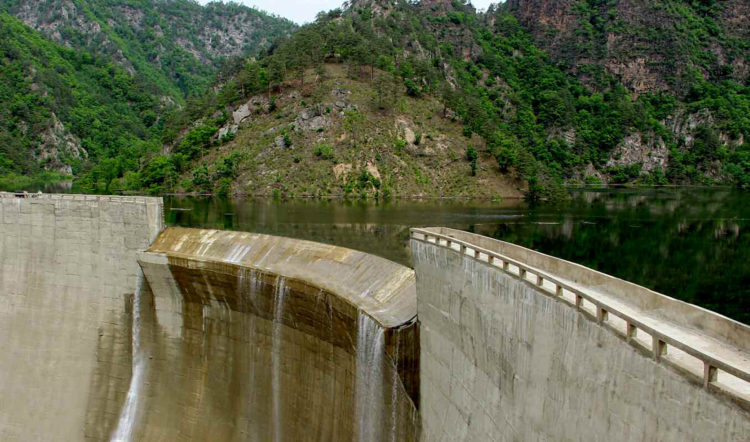
Image credit: Rodong Sinmun, July 12, 2020.
The first indications of construction of the Changpo Reservoir Dam were observed during 2014 and 2015 when a remote logging camp at 41.401541, 129.269137, approximately 12kilometers (7 miles) northwest of the Palhyang Dam, was expanded into a construction workers’ camp. Construction of the dam itself, however, was first observed on July 13, 2018, when excavation operations were noted on both sides of the Orangchon at 41.403348, 129.264487. Three months later, on October 20, a cofferdam was erected on the east bank to allow for construction of the dam foundation on the riverbed. The same month, the construction workers’ camp reached its current size of approximately 85 structures of diverse types, and a small bridge was erected over the river. Imagery from November 10, 2018, shows that the first section of the foundation had been poured. During January and February 2019, a small bridge was built across the river 50 meters (164 feet) south of the dam. Imagery from May 20, 2019 shows continued construction, with the dam’s foundations extending across the river. excavation for the entire dam stretching approximately 180 meters (591 feet), and a large crane and small batch plant are operational. Construction of the dam continued through the first half of 2019, and on July 11, 2020 North Korea announced that the dam and the No. 4 Power Plant had been completed.
The latest image, from October 1, 2020, shows that the dam was impounding water and that the Changpo Reservoir now extended 2.5 kilometers (1.6 miles) upstream.
North Korean sources indicate that the Changpo Reservoir Dam is 45 meters tall and feeds the No. 4 Power Plant via a 6.6-kilometer-long water tunnel that drops 180 meters (591 feet) down river.
No. 4 Power Plant
The No. 4 Power Plant is located at 41.366380, 129.325260, approximately 5.7 kilometers (3.5 miles) northwest of the Palhyang Dam and downriver of the Changpo Reservoir Dam. The first indication of construction was observed in late 2012, when a small workers’ camp of approximately seven structures was established at the site in preparation for digging a water pipeline to the Changpo Resvervoir Dam. On October 17, 2013, scarring from the excavation of a road going up the steep hillside was visible; construction of this road, with its numerous switchbacks, continued slowly over the next three years. By October 6, 2016, the road extended far up the hillside, where construction of the presumed water tunnel to the Changpo Reservoir Dam had begun and the construction workers’ camp had been expanded. Imagery from September 12, 2018, shows the first excavation for the foundation of the No. 4 Power Plant. On April 4, 2019 Premier Pak “…discussed the issues of supplying in time and in a responsible manner the equipment and materials needed for projects at the construction sites of Orang-chon Power Station No. 4 [and the] Palhyang Dam.” 6 Two weeks later, Rodong Sinmun declared that “the military will go to … the No. 4 power plant construction site to make an aggressive political business that stir the hearts of the public.”
North Korean media reported on April 5, 2019, that construction of the No. 4 Power Plant’s water tunnel was ahead of schedule. Four days later, during a visit to the construction site on April 9, 2019, Premier of the Cabinet Pak Pong-ju (also a member of the Presidium of the Political Bureau of the Central Committee of the Workers’ Party of Korea and vice-chairman of the State Affairs Commission) indicated that the construction of the No. 4 Power Plant was a high priority for the regime. During his visit, he “discussed the issues of supplying in time and in a responsible manner the equipment and materials needed for projects at the construction sites of Orangchon Power Station No.4 [and the] Phalhyang [sic] Dam.” 7 Construction of the power plant continued through most of 2019, and on July 11, 2020, North Korea reported that the construction of the No. 4 Power Plant and the Changpo Reservoir Dam had been completed. 8
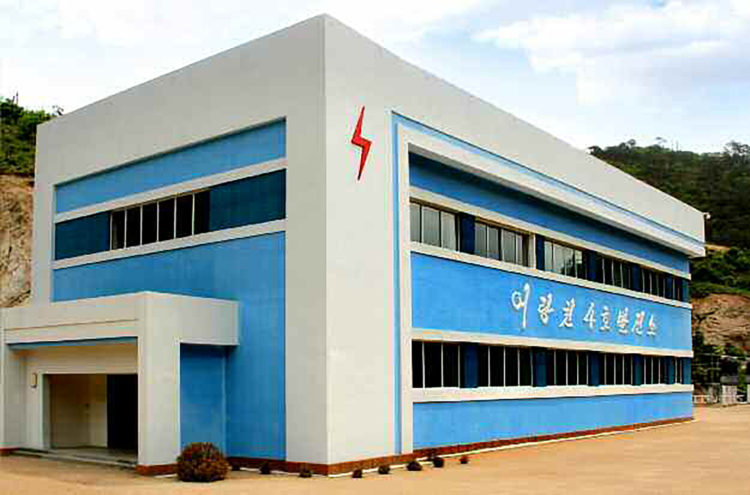
North Korean sources state that the No. 4 Power Plant is fed via an approximately 6.6-kilometer (4.1-mile) water tunnel that has an elevation drop of 180 meters (591 feet). The water used here is then discharged back into the Orangchon. These same North Korean sources indicate that the plant has a designed generating capacity of 2,500 kW.
Kwangduk Reservoir Dam and No. 3 Power Plant
The Kwangduk Reservoir Dam is located at 41.45448, 129.22417, approximately 6.7 kilometers (4.2 miles) northwest of the Changpo Reservoir Dam. As of December 2020, the precise location of the No. 3 Power Plant remains unknown. North Korean media reports often talk of the dam and power plant together, suggesting that they are co-located. This, however, remains to be confirmed. Two construction sites (at 41.450143, 129.251225 and 41.441270, 129.254190) downriver of the Kwangduk Reservoir Dam are potential alternate locations.
The first indications of construction of the dam were observed during September to October 2018, when a large construction workers’ camp was built at 41.439307, 129.241993. Though southwest of the dam site, this camp appears to be equidistant to several other construction sites along the Orangchon to the southeast. At least three additional construction camps were subsequently built around the dam construction site itself. In early 2020, several North Korean reports indicated that completion of the dam was planned by the end of the year in recognition of the seventy-fifth anniversary of the founding of the Workers’ Party of Korea—a deadline it missed. 9 An image published by North Korean media on July 15, 2020, shows a ground-level view of the dam under construction.
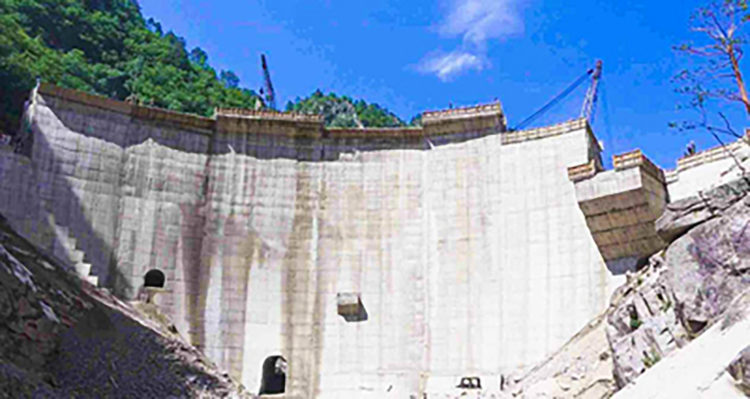
In July, South Korean media reported that construction was 65 percent complete. By August, the dam was reported to be 71 percent complete. North Korea was focusing its construction resources on this dam and power plant, as indicated by an August 11, 2020 report in the official newspaper stating that the construction cranes used on the Palhyang Dam were being relocated to the Kwangduk Dam.
The latest available satellite image, from May 4, 2020, shows that the base of the dam stretches approximately 105 meters (344 feet) across the riverbed and that the three construction camps and the camp to the southeast are all operational.
It is presently too early to estimate when the Kwangduk Reservoir Dam or No. 3 Power Plant will be completed.
International Case Study 1: Nurek Hydropower Plant Rehabilitation, Tajikistan
Nurek Hydropower Plant (HPP), the largest hydropower plant in Central Asia, was originally commissioned in 1972. In May 2017, the World Bank—in coordination with the Asian Infrastructure Investment Bank (AIIB) and the Eurasian Development Bank—initiated a project to restore the generating capacity and improve the safety and efficiency of the dam’s three units. Phase I of rehabilitation demonstrates how adhering to international standards can promote positive economic, environmental, and governance outcomes.
Quality Evaluation
Principle 1: Sustainable Growth and Development
With an installed capacity of 3,000 megawatts (MW), Nurek HPP generates 70 percent of Tajikistan’s total annual energy requirement. Prior to the start of rehabilitation, the dam was operating at 77 percent of installed capacity, with one of the units offline due to a major failure of the transformer. Without rehabilitation, it was estimated that the plant’s annual power-generation capacity could drop from 2,310 MW to 760 MW by 2030. The World Bank project intends to restore 4–12 percent of Nurek’s generating capacity, reduce Tajikistan’s overall greenhouse gas emissions, and contribute to Tajikistan’s international commitment under the United Nations Framework Convention on Climate Change.
Principle 2: Economic Efficiency and Life-Cycle Costs
The World Bank has conducted economic, financial, and sensitivity analyses to justify the rehabilitation project, including forecasts of future electricity demand and implementation of multiple risk management plans to address delays, cost overruns, and other disruptions. An internationally recognized consulting firm carried out the feasibility study, which included cost estimates and recommendations for reducing risks and increasing safety. Afterward, the World Bank released a three-part project plan. The refurbishment will increase efficiency of the generating units through improved hydraulic design and the installation of more efficient equipment. The project officially commenced on March 20, 2019, with an anticipated completion date of December 31, 2023. As of April 2020, contracts for the project were awarded through open, international bidding processes, and as of October 2020, no delays were reported.
Principle 3: Environmental Considerations
Nurek’s EIA is freely available on the World Bank’s website and brings attention to the project’s impact on the local environment. According to the EIA, the project is expected to reduce Tajikistan’s overall greenhouse gas emissions by 68 million tonnes of carbon dioxide equivalent (tCO2e), which will allow the plant to achieve a net present value of $2.077 billion. The World Bank has also implemented an environmental health and safety plan to guide monitoring of air and water quality. Barqi Tojik (BT), the state-owned company that oversees power generation in Tajikistan, will continually assess environmental safeguards and compliance throughout the plant’s life cycle. 10 As part of the project, BT will receive capacity and quality assurance from the World Bank and will be routinely audited.
Principle 4: Disaster Risk Management
The stakeholder engagement plan (SEP) prepared by BT lists 12 vulnerabilities that BT must address, including the dam’s ability to withstand extreme flood waters, as considered in a separate feasibility study. 11 The resulting analysis indicated that an improved flood forecasting system, combined with delayed reservoir filling for enhanced flood routing during years of expected high floods, could significantly improve the structure’s flood-handling capacity. The project also includes an emergency preparedness plan. 12 However, it is unclear if BT has obtained disaster risk insurance for the project.
Principle 5: Social Considerations
The SEP includes a grievance redress mechanism (GRM) to facilitate the resolution of community concerns about the project, and BT committed to spreading awareness about the GRM and the project among the local community, especially women, children, and other vulnerable populations. 13 However, in November 2020, complaints of unanticipated blackouts surfaced among local residents which BT attributed to ongoing maintenance at Nurek. The project will require little unskilled labor that would generate local job opportunities; however, after consultations with local stakeholders, it was determined that employment was not a critical concern. Following a field visit to the plant, the World Bank observed that rules and operational procedures designed to ensure occupational health and safety, such as employees wearing personal protective equipment, are broadly followed. However, the plant did have some room for improvement related to aging facilities and low lighting. 14
Principle 6: Governance
All financing amounts and terms are publicly available on the AIIB’s website. BT followed World Bank bidding standards to conduct an open and competitive bidding process. 15 The approval of Tajikistan’s program on Financial Recovery of BT in April 2017 reflects the government’s commitment to improving BT’s financial situation. The World Bank acknowledges that the risk of corruption is high in Tajikistan yet believes the country’s national anti-corruption framework, combined with the high level of political support for the project, will help mitigate these risks. The project management consultant will also provide further corruption mitigation through due diligence on cost estimates. 16
International Case Study 2: Payra Coal-Fired Power Plant, Bangladesh

On June 19, 2019, Chinese and Bangladeshi construction workers clashed at Payra Power Plant after a local laborer fell to his death. A deeper investigation into the Bangladesh-China Power Company Limited (BCPCL) project revealed not only poor social safeguards, but also weak environmental protections and inadequate disaster risk management. Despite Bangladesh’s acute need for electricity and the plant’s significant generation potential, these shortcomings threaten to outweigh the project’s benefits if not addressed. Beyond Bangladesh, the project illustrates the potential costs of not applying adequate safeguards.
Quality Evaluation
Principle 1: Sustainable Growth and Development
Bangladesh suffers from significant energy shortages, which are reflected in its development plan’s ambitious generation goals through 2041. Payra is slated to become the country’s biggest power plant, capable of generating 2640 MW of electricity—and, once completed, could potentially close Bangladesh’s electricity gap, according to a report by the China Institute of International Studies. Although the project was reportedly ready to come online in February 2020, commercial operations have been delayed in the wake of the Covid-19 pandemic. According to local reporting, the project employs an estimated 6,000 Bangladeshi workers and annual reports from BCPCL claim the company conducted 135 hours of job training in 2018 and 2019. 17 However, sustainable growth and development will hinge on whether the project can be successfully completed and efficiently maintained.
Principle 2: Economic Efficiency and Life-Cycle Costs
Payra is Bangladesh’s first ultra-supercritical coal-fired plant, which could provide an opportunity to increase energy efficiency and build local technical capacity. Ultra-supercritical coal plants use the most efficient technology available, leading to lower emissions and lower fuel costs relative to other coal-burning plants. During the first five years of its operation, the Chinese contractor will train local workers in an attempt to build some local technical capacity. However, even prior to the Covid-19 pandemic the project faced several delays, which BCPCL senior executives blame on poor stakeholder coordination. This suggests that an adequate SEP was not effectively implemented. In addition, Bangladesh’s 2016 master plan for power indicates that legal frameworks for requiring and enforcing regular inspections and O&M are inadequate, which will decrease the plant’s efficiency and increase life-cycle costs.
Principle 3: Environmental Considerations
Payra’s EIA raises several red flags. Unlike most EIAs undertaken by multilateral banks, it does not consider any alternatives to the current project. 18 Experts have raised concerns about negative impacts on a local mangrove forest, fish, and dolphin populations. The EIA recommends refraining from construction during fish breeding season. This would amount to halting construction for around half of the year, but there is no evidence that construction has stopped during breeding times. Furthermore, the EIA was taken offline, and although CSIS obtained a copy and it has now been made publicly available once again, stakeholders may not have had adequate time to review it before the project moved forward.
Principle 4: Disaster Risk Management
Coastal storms pose a serious risk to the project, which is located on the banks of the Galachipa River, approximately 25 kilometers (16 miles) inland from the Bay of Bengal. The funneling coastline of Bangladesh, its uniquely high tides, a low flat coastal terrain, and a high population density have produced some of the highest mortality figures associated with storm surges in the world. Rapid siltation caused by even a medium-scale storm could block the channel used to supply the plant with coal. Even without storms, the channel will require costly regular dredging, which one Bangladeshi scholar has called “literally throwing money into water.” The project is insured through Sinosure, but it is unclear if this includes coverage for natural disasters.
Principle 5: Social Considerations
The Social Impact Assessment (SIA) estimated that land acquisition for construction would result in the eviction of around 560 locals. About 130 families affected by the power plant have been provided new residences and public facilities under a resettlement action plan. However, locals employed in agriculture and livestock rearing will be forced to adopt alternative occupations, deal with increased land prices, and face degradation of their local environment. They do not currently possess the technical skills required to work at the power plant. The deaths of one worker in June 2019 and another in November 2019 underscore occupational health and safety concerns.
Principle 6: Governance
Lacking sufficient financial resources to establish a power plant independently, Bangladesh’s state-owned power company formed the BCPCL, a 50:50 joint venture with the China National Machinery Import and Export Corporation. In 2016, this joint venture awarded the contract to build the first two units of the plant to a Chinese consortium, which was the sole bidder. Only companies with “a good working relationship” with Dongfang Boiler Group and Shanghai Electric Company, the plant’s original equipment manufacturers, were eligible to bid on the contract for its operation and maintenance. 19 There is no evidence that a debt-sustainability analysis was conducted.
International Case Study 3: Angren Thermal Power Plant, Uzbekistan

Angren Thermal Power Plant (TPP) is located approximately 80 kilometers (50 miles) southeast of Tashkent, Uzbekistan. The plant was originally launched in 1953 and by 1963 had an installed capacity of around 480 MW. By 2013, however, its available capacity had decreased to 31.4 percent, with four of the eight original units scheduled for decommissioning in 2017 and the remaining four slated for decommissioning in 2020. To address the plant’s severe under-performance and obsolete equipment, the plant’s owner, the state-run joint stock company Uzbekenergo, planned to begin installing an additional 150-MW coal-generator unit in 2016. The plan called for Uzbekenergo to invest $75.1 million of its own funds for the project, while the Export-Import Bank of China (China EXIM) agreed to lend an additional $165.6 million. 20 Harbin Electric International Co., Ltd. (HEI) was contracted for the project’s construction. Ultimately, the installation of this new unit raises several red flags and serves as an example of what to avoid in infrastructure investment.
Quality Evaluation
Principle 1: Sustainable Growth and Development
It does not appear that China EXIM provided any project preparation assistance or capacity building for the installation of the new unit, with the exception of providing training for 21 young Uzbeks who took over operations of the plant in 2016. In addition, although Angren TPP was designed to use coal with a maximum ash content of 25 percent, it has often used coal with a higher ash content, which does not produce a high enough temperature to generate electricity efficiently. Higher-quality coal with a lower ash content has been stolen during transportation from the Angrensky coal mine near the plant.
Principle 2: Economic Efficiency and Life-Cycle Costs
The supply of lower-quality coal with high ash content is incompatible with the new unit at Angren TPP and frequently causes blockages and equipment breakdowns, exacerbating O&M costs. An equipment breakdown in January 2020 caused a fire, which a special commission is investigating. 21
There do not appear to be any mechanisms in place to address cost overruns, nor is it clear whether any legal framework was followed for this project. Moreover, it is not apparent that China EXIM provided any expertise in the areas of financial risk management and fund allocation.
Principle 3: Environmental Considerations
In a study conducted on behalf of Uzbekenergo, the Japan International Cooperation Agency (JICA) acknowledged that Angren TPP is surrounded by mountains that, combined with low winds, trap pollution in the area where the factory is located. There is no EIA publicly available for this project. While HEI claims that its equipment will reduce carbon emissions by 10,000 tons annually, JICA reports that it would be possible to reduce emissions by as much as 100,000 tons annually. 22 These contradictory figures, combined with the lack of data for the project, make it impossible to assess Angren TPP’s carbon footprint.
Principle 4: Disaster Risk Management
There is no indication that China EXIM, HEI, or the Uzbek government made disaster risk management a priority. No risk assessment is publicly available, nor do any of the available sources refer to one. The project also lacks a risk management plan, and disaster risk management does not seem to have been considered in the design of the new unit. Moreover, there is no evidence of disaster risk financing or insurance.
Principle 5: Social Considerations
No assessment of the project’s social impacts has been made public. No sources mention any inclusive practices or community consultation. The failure to mention occupational health and safety measures taken for the installation of the new unit is also concerning. Finally, the JICA-backed study reveals that the nearest residence is only about 300 meters (980 feet) from the plant. Despite the proximity to local populations, the project’s planners do not seem to have considered Angren TPP’s public health impacts on the residents of nearby Angren city, where 126,962 people live.
Principle 6: Governance
Terms for the loan provided by China EXIM are publicly available and include government guarantees for the funds borrowed by Uzbekenergo. This is likely linked to the company’s dire financial situation. According to a local report from 2016, the company was so deeply in debt at the time that it was nearly bankrupt and unable to pay its employees’ salaries, leading to the ouster of its chairman of the board. Despite the sovereign bank guarantees, there is no publicly available assessment of the project’s impact on Uzbekistan’s overall debt sustainability.
Few official details describing the procurement process for the project are accessible via open sources save that HEI won the contract for project construction. In terms of corruption, there are numerous red flags besides the lower-quality coal causing equipment breakdowns. A presidential decree from March 2013 exempts HEI from paying external customs taxes and corporate income tax and exempts the project from resolutions passed by Uzbekistan’s Cabinet of Ministers. 23 Finally, in 2019, management of Angren TPP and Novo-Angren TPP was transferred for three years to Mining Works, a Kazakh company that owns many large coal mines in Kazakhstan. This is concerning because Mining Works, as a supplier of coal, could manipulate prices for its own financial gain.
Quality Infrastructure Investment Scorecard

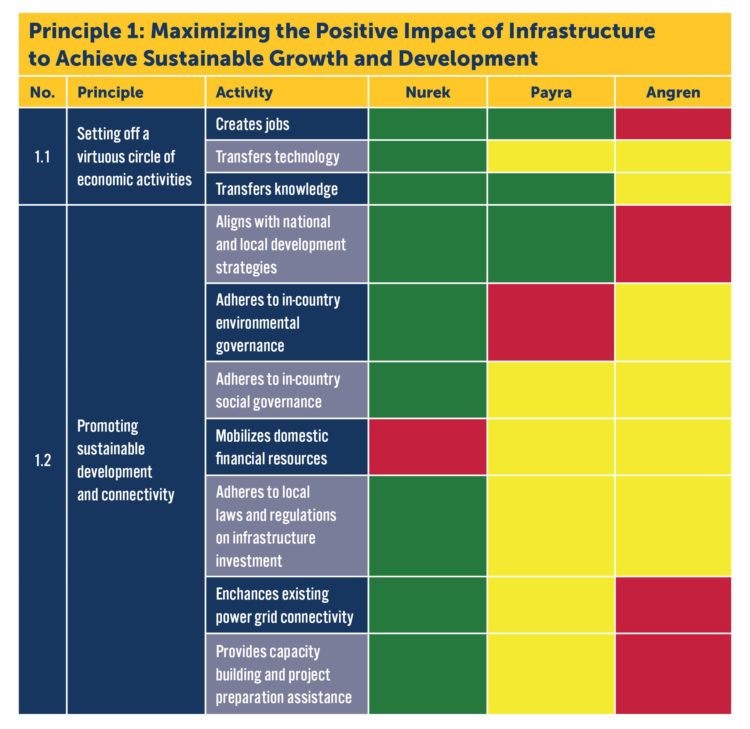
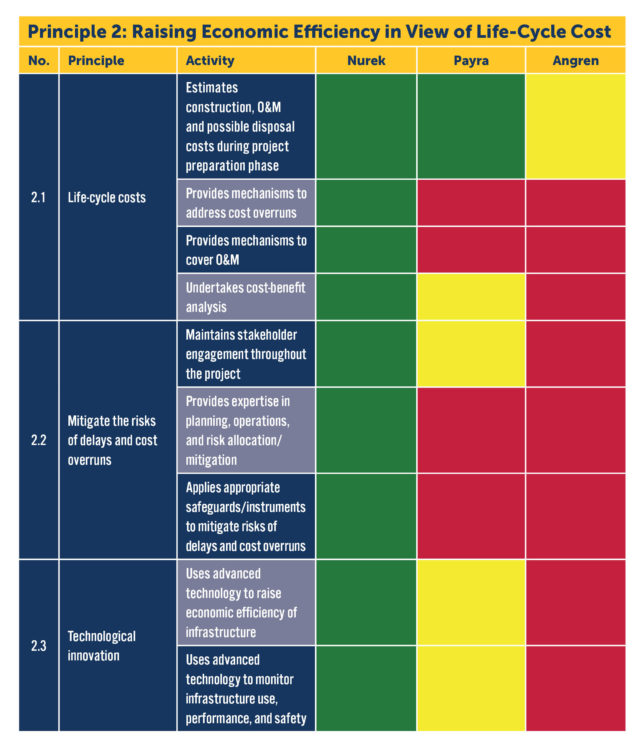


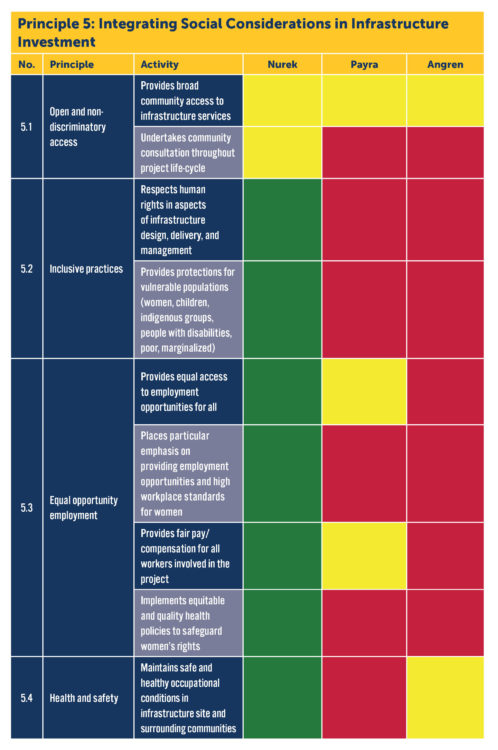

Conclusion
The cases examined in this report underscore North Korea’s dire need for energy infrastructure and the importance of it meeting the G20 quality infrastructure investment principles. Although significant political barriers remain to reconnecting the Korean peninsula, there is merit in substantive study of the types of energy infrastructure connections that would best promote regional growth and stability. This section briefly considers the strategic implications of different energy infrastructure connections for U.S. interests.
North Korea’s three neighbors all have economic and strategic interests in forging new energy infrastructure connections. However, not all these connections will contribute equally to regional prosperity and stability. China, Russia, and South Korea would bring different interests and experiences to reconnecting the Korean peninsula.
China is already active around the world, spending an estimated $275 billion in the energy sector across countries participating in the Belt and Road Initiative from 2014–19, according to the American Enterprise Institute’s China Global Investment Tracker. Home to several of the world’s largest construction and energy companies, China is eager to find new markets and has been willing to provide both domestic subsidies to its companies and foreign financing to its partners to secure new deals. Chinese firms have demonstrated an ability to deliver projects on accelerated timelines, but (as the cases examined in this study suggest) China’s weak safeguards can stoke corruption, harm the environment, and result in other adverse social and economic externalities. China has deep strategic interests in the Korean peninsula and would reap both economic and security benefits from energy infrastructure investment in North Korea. This would generate close strategic alignments on the peninsula from not just North Korea, but also from South Korea in a longer-run unification scenario.
Although Russia’s foreign infrastructure program is less robust, it is the world’s leading energy exporter. Increasingly isolated from Western markets since its illegal annexation of Crimea in 2014, Russia has turned East. In December 2019, Presidents Vladimir Putin and Xi Jinping launched the Power of Siberia pipeline, which delivers natural gas from Russia to northern China. Both leaders touted this as another sign of their growing strategic partnership. Rosatom, Russia’s state-owned nuclear energy company, is the world’s largest exporter of nuclear reactors. If given a political opening, it has suggested Rosatom could build a nuclear power plant in North Korea in 6–7 years—a proposal that would benefit Russia commercially while undermining regional stability.
Moreover, 2020 marked the thirtieth anniversary of Russian–South Korean relations. Celebrations of the anniversary, including a visit by Vladimir Putin to Seoul, had to be postponed due to the Covid-19 pandemic. Pending an improvement in the global health situation, Putin could visit South Korea in 2021, at which point he might seek new cooperative ventures between Seoul and Moscow on energy infrastructure with an eye to giving both parties a stake in this sector in North Korea.
Recent behavior is another important consideration and, unfortunately, China and Russia have a history of weaponizing connectivity for political ends. Over the past decade, China has cut rare earth exports to Japan, cut tourism to South Korea, closed a border crossing with Mongolia, and restricted imports from Australia, among other instances of politically motivated economic coercion. 24 Since the collapse of the Soviet Union, Russia has manipulated energy volume and prices to coerce countries in Europe and Central Asia. Both China and Russia have also exported energy illegally to North Korea, demonstrating their willingness to undermine policies established by the international community.
This track record highlights the risks of allowing China or Russia to monopolize new connections across the Korean peninsula. Doing so would carry political, economic, and strategic costs. It would weaken governance by spreading corruption and poor business practices; deliver infrastructure projects of lower social and economic value; and increase the coercive power of these actors, which have demonstrated a willingness to cut off economic flows for political ends.
The region would be better served by an approach that favors openness and transparency, applies appropriate safeguards, and fosters development without dependency. In this regard, aspects of South Korea’s own experience are worth emulating.
The region would be better served by an approach that favors openness and transparency, applies appropriate safeguards, and fosters development without dependency. In this regard, aspects of South Korea’s own experience are worth emulating. With its entire population having access to a high-quality electricity supply, South Korea is among the top ten countries in the world for energy access and security. Though its energy transition is ongoing, South Korea’s remarkable transition from low- to high-income status provides an example to aspire to.
Of course, it is not realistic to expect that North Korea would entirely forgo new energy connections with China and Russia. What must be minimized, however, is their ability to gain undue influence under the guise of promoting development. If Chinese and Russian projects meet the G20 quality infrastructure investment principles and do not threaten to create risky regional dependencies, they should proceed. North Korea’s infrastructure investment needs likely exceed the appetite of any single country. Over time, the Korean peninsula will also benefit from public and private international investment in its energy infrastructure, as well as from energy connections with the broader Eurasian landmass.
The United States should work closely with South Korea and its other partners and allies in the region on contingency planning—not only to prepare for security threats, but also to capitalize on political and economic opportunities.
The United States should work closely with South Korea and its other partners and allies in the region on contingency planning—not only to prepare for security threats, but also to capitalize on political and economic opportunities. In the event of a political resolution, the United States could provide technical support that helps reduce the likelihood of adverse outcomes and encourage energy connections that meet basic quality principles. For example, the United States, South Korea, and North Korea all use the same frequency of 60Hz in their electricity system, while China and Russia use a 50Hz grid system, making it more cost effective for North Korea to consider working with similar 60Hz grid countries. South Korea has proven capacities in providing high-quality electricity systems based on 60Hz. Of course, implementing these plans will remain contingent upon North Korea’s willingness to meet its international obligations.
In the meantime, this strategic planning has the added benefit of reinforcing the U.S.–Korean alliance as a stabilizing force for peninsular prosperity and security, as well as and developing expertise that can be applied to encourage quality infrastructure development in the region and beyond.
References
- Republic of Korea Ministry of Unification, “러 기술진, (평양화력발전소)설비 점검” (Russian technicians check facilities at Pyongyang Thermal Power Plant), North Korea Information Portal, July 21, 2002, https://nkinfo.unikorea.go.kr/nkp/trend/viewTrend.do; Republic of Korea Ministry of Unification, “주요발전소” (Major Power Plants) https://nkinfo.unikorea.go.kr/nkp/main/portalMai n.do. ↩
- Mun Dong Hui, “문동희, “전기공급에도 차별?…평양 중심구역엔 하루 5시간, 그 외 지역엔…” (Discrimination in Electricity Distribution? .. 5 hours a day in central Pyongyang, but in other areas…), Daily NK, June 5, 2019, https://www.dailynk.com/전기공급에도-차별평양-중심구역엔-하루-5시간-그/; Peter Hayes, “Should the United States Supply Light Water Reactors to Pyongyang?”, https://nautilus.org/napsnet/napsnet-special-reports/should-the-united-states-supply-light-water-reactors-to-pyongyang/. ↩
- It is important to note that declassified high-resolution satellite imagery is not readily available after 1972 and high-resolution commercial satellite imagery did not become readily available until 1999. ↩
- “Kim Jong Un Inspects Orangchon Power Station under Construction,” Rodong Sinmun, July 17, 2018, available at https://kcnawatch.org/newstream/1531820717-575366928/kim-jong-un-inspects-orangchon-power-station-under-construction/; “N. Korean Leader Tours Construction Sites, Chides Officials for Incompetence,” Yonhap News Agency, July 17, 2018, https://en.yna.co.kr/view/AEN20180717001051315. ↩
- “Pak Pong Ju Inspects Units in North Hamgyong Province,” KCNA, April 9, 2019, http://kcna.co.jp/item/2019/201904/news09/20190409-19ee.html; Kim Yoo Jin, “Mass deployment of officials to rural areas following leader’s criticism,” Daily NK, August 10, 2018, https://www.dailynk.com/english/mass-deployment-of-officials-to-rural-areas-following-leaders-criticism/. ↩
- “Pak Pong Ju Inspects Units in North Hamgyong Province,” KCNA, April 9, 2019. ↩
- As recently as April 9, 2019 Premier of the Cabinet Pak Pong Ju visited the Orang-chon Power Station Project where he “…discussed the issues of supplying in time and in a responsible manner the equipment and materials needed for projects at the construction sites of Orangchon Power Station No.4, Phalhyang Dam and Yombunjin Hotel.” “Pak Pong Ju Inspects Units in North Hamgyong Province,” KCNA, April 9, 2019. ↩
- “Orang-chon Power Station No. 4 Power Plant Completed,” KCNA, July 11, 2020. ↩
- Hong Seong-jun, “어랑천3호발전소건설에로 대중을 조직동원” (Organizational Mobilization of the Public to Construct the Orang-chon No. 3 Power Plant), Rodong Sinmun, April 25, 2020, available at https://kcnawatch.org/newstream/1587762073-400104977/어랑천3호발전소건설에로-대중을-조직동원/; Lee Eun-nam, “10여개 대상공사 힘있게 추진” (Strong Promotion of Ten Target Projects), Rodong Sinmun, January 30, 2020, available at https://kcnawatch.org/newstream/1580332820-576889051/10여개-대상공사-힘있게-추진/. ↩
- Asian Infrastructure Investment Bank, Project Document of The Asian Infrastructure Investment Bank: Nurek Hydropower Rehabilitation Project Phase I. ↩
- The World Bank, Project Appraisal Document on Proposed Credits in the Amount of US$169.135 Million and a Proposed Grant in the Amount of US$56.565 Million Equivalent to the Republic of Tajikistan for a Nurek Hydropower Rehabilitation Project – Phase I. ↩
- Asian Infrastructure Investment Bank, Project Document of The Asian Infrastructure Investment Bank: Nurek Hydropower Rehabilitation Project Phase I. ↩
- The World Bank, Project Appraisal Document on Proposed Credits in the Amount of US$169.135 Million and a Proposed Grant in the Amount of US$56.565 Million Equivalent to the Republic of Tajikistan for a Nurek Hydropower Rehabilitation Project – Phase I. ↩
- Barqi Tojik Open Joint Stock Holding Company, Nurek Hydropower Rehabilitation Project: Environmental and Social Impact Assessment Final Report. ↩
- Asian Infrastructure Investment Bank, Project Document of The Asian Infrastructure Investment Bank: Nurek Hydropower Rehabilitation Project Phase I. ↩
- The World Bank, Project Appraisal Document on Proposed Credits in the Amount of US$169.135 Million and a Proposed Grant in the Amount of US$56.565 Million Equivalent to the Republic of Tajikistan for a Nurek Hydropower Rehabilitation Project – Phase I. ↩
- “Annual Report 2019,” Bangladesh-China Power Company, 2019, https://www.bcpcl.org.bd/downloading/41, “Annual Report 2018,” Bangladesh-China Power Company, 2018, https://www.bcpcl.org.bd/downloading/37, and “Local workers asked to leave plant site,” The Daily Star, June 23, 2019, https://www.thedailystar.net/backpage/payra-power-plant-stay-out-until-we-say-so-1760860. ↩
- See, for example Norconsult, Environmental and Social Assessment for the Thaton Gas-Fired Power Plant, Mon State, Myanmar – Report (Norconsult, The World Bank, August 6, 2013), http://documents.worldbank.org/curated/en/312411468059719921/pdf/E42450v10REVIS000PUBLIC00Box379823B.pdf. ↩
- Bangladesh-China Power Company Limited, Request for proposal for operation and maintenance of Payra Thermal Power Plant (2 x 660MW). ↩
- “Uzbekistan and Tajikistan to Integrate Electricity Grids,” The Economist Intelligence Unit, November 13, 2017, http://country.eiu.com/article.aspx?articleid=616113845; “Harbin Power to modernize Angren thermal power station,” UZ Daily, June 20, 2013, http://www.uzdaily.uz/en/post/23620. ↩
- “Yangi-Angren TPP catches fire,” The Tashkent Times, January 20, 2020, https://tashkenttimes.uz/national/4925-yangi-angren-tpp-catches-fire; “Massive Fire Hits Thermal Power Station in Uzbekistan,” Radio Free Europe/Radio Liberty, January 30, 2020, https://www.rferl.org/a/massive-fire-hits-thermal-power-station-in-uzbekistan-no-casualties-reported/30407032.html. ↩
- “Шавкат Мирзиеев посетил город Ангрен, Подробно” (Shavkat Mirziyoyev Visits City of Angren), Podrobno, September 20, 2016, https://www.podrobno.uz/cat/politic/shavkat-mirzieev-posetil-gorod-angren/; Japan International Cooperation Agency, Republic of Uzbekistan Preparatory Survey on Tashkent Heat Supply Power Plant Modernization Project: Final Report. ↩
- “Presidential Resolution of the Republic of Uzbekistan on measures for the implementation of the investment project ‘Construction of an energy unit with a capacity of 130-150 MW with heating selection for burning high-ash coal at Angren TPP.” ↩
- Keith Bradsher, “Amid Tension, China Blocks Vital Exports to Japan,” The New York Times, September 22, 2010, https://www.nytimes.com/2010/09/23/business/global/23rare.html; Ralph Jennings, “Why It Hurts Less Now As China Punishes South Korea With Tourism Cuts,” Forbes, March 4, 2018, https://www.forbes.com/sites/ralphjennings/2018/03/04/china-keeps-punishing-south-korea-with-tourism-cuts-for-now/#32239eb366c4; Adrian Brown, “China ‘blocks’ Mongolia border after Dalai Lama visit,” Al Jazeera, December 10, 2016, https://www.aljazeera.com/news/2016/12/china-blocks-mongolia-border-dalai-lama-visit-161210060313417.html; Victor Cha and Andy Lim, “Flagrant Foul: China’s Predatory Liberalism and the NBA,” The Washington Quarterly 42, Issue 4 (December 20, 2019): 23-42, https://doi.org/10.1080/0163660X.2019.1694265. ↩

